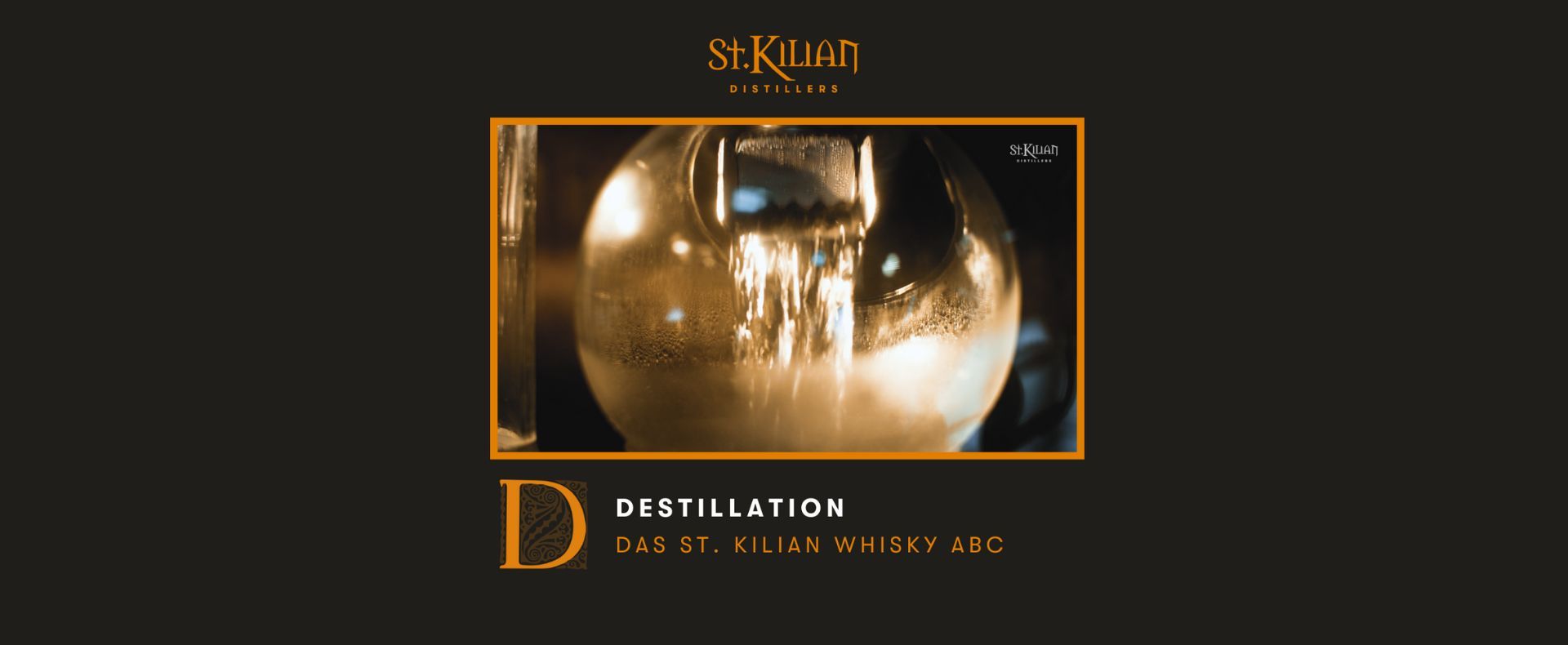D - like distillation

What is distillation?
Distillation is a physical process for separating liquids that have different boiling points. The principle is based on the fact that at a given temperature, the liquid with the lower boiling point (e.g. ethanol at 78.3°C) evaporates first, while the liquid with the higher boiling point (e.g. water at 100°C) remains behind.
How does distillation work in the distillery?
At St. Kilian Distillers, the fermented solution, the wash, is first heated in the first copper still (wash still). At an internal temperature of 78.3°C, the potable ethanol evaporates and rises as steam in the still. Since the wash contains many other alcohols and aromas besides ethanol and water, which we would like to extract from the wash, the temperature in the wash still is continuously increased up to 102°C.
How is the steam liquefied again?
Once a liquid substance evaporates, the vapors rise up the pot still, pass from the neck of the still and down the Lyne arm into the shell and tube condenser, where they are re-liquefied by cooling with cold water and collected in a container.
How long has distillation been around?
The history of distillation goes back far into antiquity, but its origins cannot be clearly confined to a specific region. As early as the 2nd millennium BC, distillation was used to produce essential oils and perfume in Mesopotamia, today's Iraq.
What equipment was used to perform distillation in the past?
In the past, distillation was carried out in a so-called alambic (also alambic or alembic). This is a simple distillation apparatus consisting of three components: a still, a helmet and a condenser. Today's copper pot stills at St. Kilian are basically modeled on these ancient distillation apparatuses.
What are the advantages of pot stills?
For the production of single malt whisky, double distillation in the copper pot stills offers the advantage over continuously operating distillation columns that this process results in a rather coarse separation of the various alcohols and aroma substances in the wash. As a result, we do not obtain a distillate that is too pure and lacking in aroma, but rather one that is richer in content and enriched with a certain amount of base substances. This is what we want, because this distillate can then mature in the wooden barrels to a characterful and complex St. Kilian Single Malt Whisky.
What disadvantages do they have?
Compared to other distillation apparatuses, such as the columns used in continuous distillation, the Coffey Stills or Column Stills, distillation in the Pot Stills requires significantly more energy and time.
What happens if distillation is too fast?
In terms of distillation speed, a gentle approach is the way to go. Especially during the second distillation in the Spirit Still, the liquid contents should not be heated too quickly. This is because heating too quickly leads to rapid evaporation and entrains undesirable compounds along with the desired alcohols and aromatics. This too rapid distillation ultimately leads to significant contamination of the distillate with a number of base compounds.
How often is distillation done at St. Kilian?
At St. Kilian, we distill twice. The wash, i.e. the slightly alcoholic beer after fermentation, is first distilled in the wash still and the entire distillate is collected after cooling. In the second copper still, the Spirit Still, we separate the base, undrinkable, and sometimes even toxic substances in the forerun and overrun from the desired, noble aroma substances in the middle run, our heart. The middle run is collected and later goes into the barrel for aging. A small part of the middle run is bottled by us as New Make and can be tasted during tours of our distillery.
What happens to pre-carriage and post-carriage?
Pre-run and post-run after distillation in the Spirit Still still contain a usable amount of desirable aromas and ethanol in addition to the undesirable aroma substances. For this reason, the pre-run and post-run are added to the next distillate obtained after the first distillation in the wash still and redistilled together in the spirit still. For us, this represents an extremely decisive factor for the quality of our St. Kilian whiskies. This is the central system for preserving - in addition to ethanol - the flavors in the pre-distillate and post-distillate.